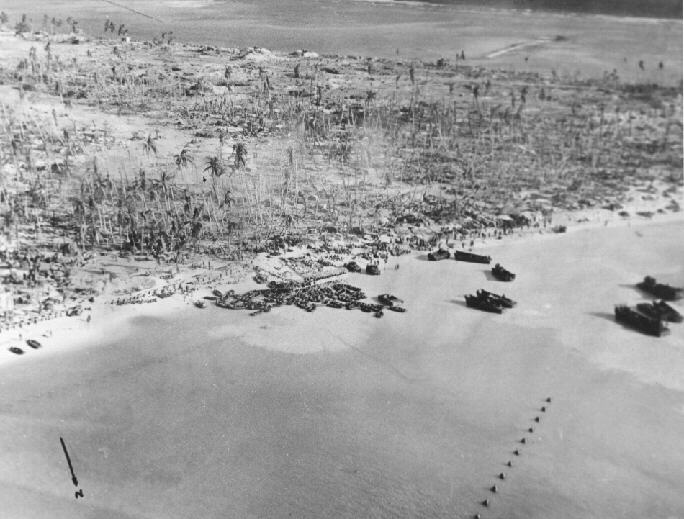We were in the third wave,and on reaching the coral received fire. Fired the 5O cal. MGs on the AmphTracs as we went in, but the tracs bounded around considerably. On landing I received orders from Colonel Jordan to push ahead, and by noon got to the air strip. I had no communication, so I went back to the CP and was ordered to set up in frcnt of the CP, which I did. We moved up the next morning. I had a Sergeant and six men and sent them tc the left flank to contect Major Crowe's outfit at the head of the pier.
We did not get much fire from the pier itself, because I believe Lt. Hawkins was already on the pier. Some of the assault LVTs went over the parapet one of which went fifty yards inland.
There was a tendency for the men to crouch behind the seawall. There was also some difficulty in getting them out of the AmphTracs. Low water was about 1200. The LVTs had no trouble getting through the concrete obstacles and the barbed wire.
Two platoons in direct support of the two assault companies had LMGs; two reserve and two support platoons had HMGs. It is recommended thet the heavy gun be used on the light tripod. The heavy gun is easier to carry, the light tripod has a lower silhouette, and gives the dispersion you want. The main reason for not using the LMGs is because of the necessity for carrying spare barrels. Also, the men had more confidence in the heavy.
With the exception of grenades there was no real shortage of any ammunition at any time. However, some rifle ammunition was collected from the dead.
M-l - Salt water caused numerous stoppages with the M-1s. We had to organize three men as a cleaning detail to work them ever. However, the men like it's fire power and still prefer it to the '03.
The BAR did not work too well because of the sand. The main trouble was in the action, and not in the magazine. The carbine is fine. We had few or no stoppages.
Inflated life belts - There were several wounded men picked up out of the water wearing inflated life belts.
The shore party was used as infantry. The night they started working on the gear organization was good. I do not think the shore party shou1d be brought in early when there is no beach head.
Communication - We had a TBY which we managed to keep dry. Some provision must be made to keep communication equipment water proofed. It is reccommended that a duplicate set of signal equipment with a water-proof covering be carried so that it may be floated in in case of emergency.
We did not get any notice of approaching Japanese planes. Our set was on the right frequency, but ships did not want to open up and reveal their position; They had the planes recorded on their radars. We expected that when they got a bogey they would give us the word, but the only time we got it was from our Air Liaison Officer.
Ammunition replenishment was good, but men were wounded in getting 81mm mortars ammunition over the side of the AmphTracs. Perhaps a rubber boat could be towed behind an LVT for that purpose.
The 37mm crews were used as infantry and the breach blocks of the guns were removed and hidden. Two guns however were set up in the triangle and we lost five out of six men. It was reported that these guns fired on some targets.
It is recommended that similar radios be used for tanks and infantry.
The collecting section functioned well but there was a shortage of personnel. The present set up is believed to be sound under ordinary circumstances, but not so if casualties are exceptionally high.
source: "REPORTS OF BATTALION COMMANDERS", 22 December 1943.

copyright 2003 Wheaton, Illinois
Created 22 June 2003

Return to Index